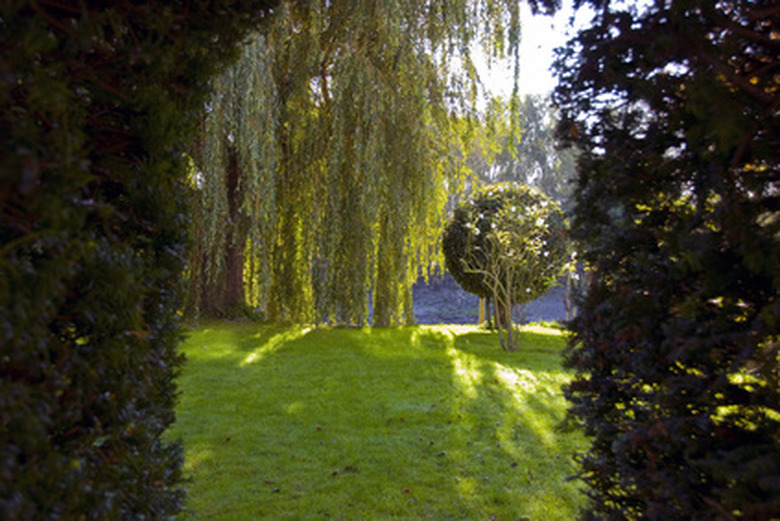The Best Grass Seeds For Growing In The Shade
Nearly all turfgrasses are accustomed to growing in wide-open, sunny spaces, so selecting grass seeds for shaded lawn areas can be difficult. Some grass seeds will grow in the shade, while other types won't. Those grass seed types that have shade tolerance will grow more upright with thinner blades and shallower roots than in the sun. Selecting a cool-season grass seed for shaded lawn areas is somewhat easier than finding a shade-tolerant warm-season grass seed. Several cool-season grasses have a high tolerance for shade, while only one or two warm-season grasses can withstand shade.
Fescues
Fine fescue grasses, including the creeping, hard and chewings fescue varieties, are cool-season grasses that are highly-shade tolerant. Fescues are grown in colder climates, are drought-tolerant and stay green year round. Tall fescue is also a good choice, but it isn't quite as shade-tolerant as the fine fescues and can grow in moderate shade. Tall fescue is much more resistant to wear and tear from heavy foot traffic and is coarser in texture than fine fescue, however. All fescue grasses establish easily from seed and require moderate maintenance.
- Nearly all turfgrasses are accustomed to growing in wide-open, sunny spaces, so selecting grass seeds for shaded lawn areas can be difficult.
- Fine fescue grasses, including the creeping, hard and chewings fescue varieties, are cool-season grasses that are highly-shade tolerant.
Rough Bluegrass
Rough bluegrass is another shade-tolerant grass for colder climates, but the seed can take up to eight weeks to establish. Rough bluegrass is low-maintenance, creates a medium-textured lawn and can withstand low to medium foot traffic. Once established, rough bluegrass is fast-growing and can mend itself when bare patches emerge in the lawn by spreading through its vigorous root system.
Zoysiagrass
St. Augustine grass is the best warm-season grass choice for shade tolerance, but it's rarely grown successfully from seed and is instead established using plugs or sod. You next best choice for a warm-season, shade-tolerant grass is zoysiagrass. Native to China and Japan, zoysiagrass grows best in climates with hotter summers and mild winters. Although slow-growing, Zoysiagrass is highly drought-tolerant and extremely wear-resistant. Zoysiagrass has a medium to fine texture and requires moderate to high levels of maintenance, with regular fertilization and mowing. Many zoysiagrasses are also susceptible to pests and some fungal diseases.
- Rough bluegrass is another shade-tolerant grass for colder climates, but the seed can take up to eight weeks to establish.
- Zoysiagrass has a medium to fine texture and requires moderate to high levels of maintenance, with regular fertilization and mowing.
Grass Seed Blends
The best shaded lawn is often established by planting a mixture of grass seeds. If you live in a colder climate, aim for a seed blend containing Kentucky bluegrass, perennial ryegrass, creeping red fescue and chewings fescue. Because most shaded lawns also have some sunny spots, a seed blend containing Kentucky bluegrass and a cool-season shade grass will ensure that at least one grass type will grow in all parts of the lawn.
